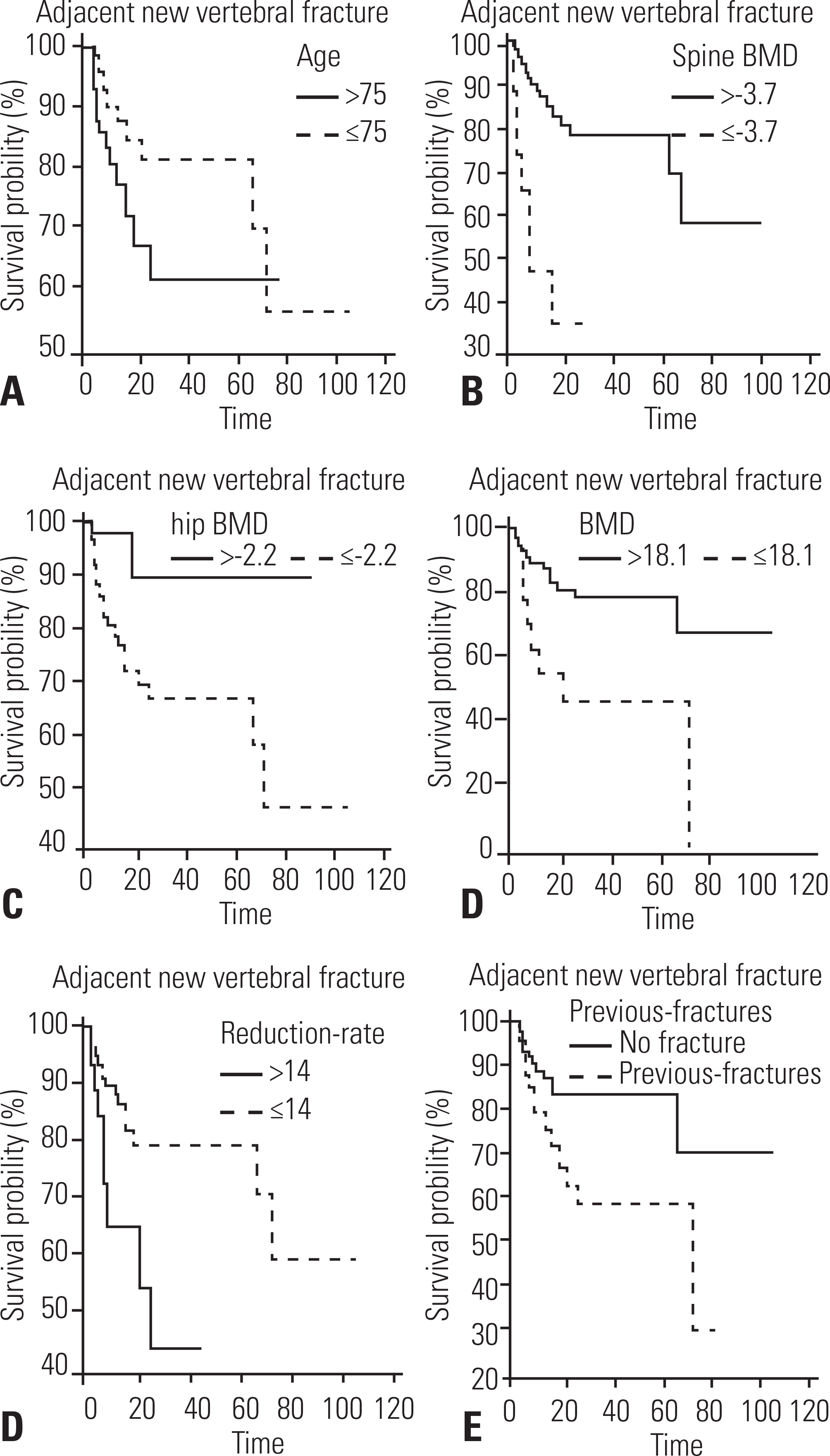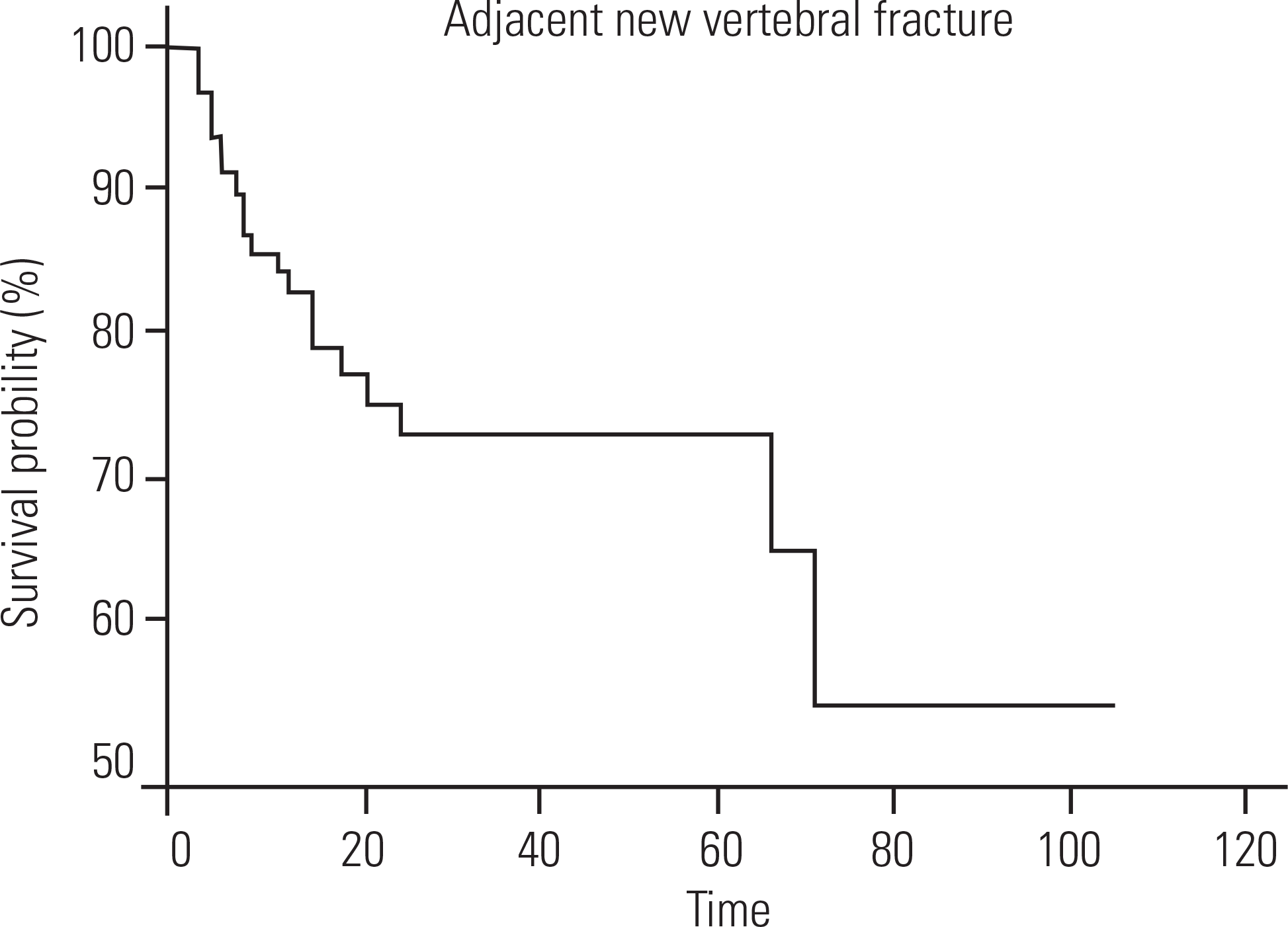Abstract
Objectives
To evaluate the factors related to the incidence of a new fracture in an adjacent vertebra after kyphoplasty for single vertebral body fracture due to osteoporosis and to assess the impact of such factors on patients'survival rate.
Summary of Literature Review
It is controversial whether fracture of an adjacent vertebra after kyphoplasty is due to the natural course of osteoporosis or as a complication of kyphoplasty.
Materials and Methods
From December 2006 to December 2016, among 490 cases of kyphoplasty for single vertebral body fracture due to osteoporosis, 153 cases were analyzed retrospectively. The survival rate was analyzed based on age, gender, body mass index (BMI), fracture level, leakage of cement, amount of cement, compression rate, recovery rate, bone density, osteoporotic medication rate and compliance, existence of a compression fracture, hypertension, diabetes, and smoking habit. The average follow-up duration was 15.1 months (range, 1 month to 8 years and 8 months) and the mean age was 74.4 years (range, 54–93 years).
Results
A new fracture in an adjacent vertebral body occurred in 27 cases (17.3%). The 1-year survival rate was 82.6%, the 2-year survival rate was 72.5%, and the 6-year survival rate was 53.7%. The survival rate was significantly higher in patients younger than 75 years (p=0.0495). The survival rate was also significantly higher in patients with a preoperative vertebral bone density greater than −3.7 and hip bone density greater than −2.2 (p<0.0001, p=0.0114). The survival rate was significantly higher in patients with a BMI greater than 18.1 kg/m2 at the time of surgery (p=0.0014). Furthermore, the survival rate was significantly higher in patients with a postoperative recovery of vertebral height of 14% or less (p=0.0031). In addition, the survival rate was higher in patients without a compression fracture before surgery (p=0.0297). In multiple factor analysis, vertebral bone density (p=0.0049) and age (p=0.0408) were identified as statistically significant factors.
Go to : 
REFERENCES
1. Charles H. Osteroporosis, an Underdiagnosed disease. JAMA. 2001; 286(22):2865–6. DOI: DOI:10.1001/jama.286.22.2865.
2. Hall SE, Criddel rA, Comito TL, et al. A case-control study of quality of life and functional impairment in women with long-standing vertebral osteoporotic fracture. Osteoporosis Int. 1999; 9(6):508–15. DOI: 10.1007/s0019800501.

3. Pradhan BB, Bae HW, Patel VV, et al. Kyphoplasty reduction of osteoporotic vertebra compression fractures: Correction of local kyphosis versus overall sagittal alignmnet. Spine(Phila Pa 1976). 2006 Feb 15; 31(4):435–41. DOI: 10.1097/01.brs.0000200036.08679.1e.
4. Tosteson AN, Gabrel SE, Grove MR, et al. Impact of hip and vertebral fractures on quality-adjusted life years. Osteoporosis Int. 2001 Dec; 12(12):1042–9. DOI: 10.1007/s001980170015.

5. Melton LJ. Adverse outcomes of osteoporotic fractures in the general population. J Bone Miner Res. 2003 Jun; 18(6):1139–41. DOI: 10.1359/jbmr.2003.18.6.1139.

6. Kallmes DF, Comstock BA, Heagerty PJ, et al. A randomized trial of vertebroplasty for osteoporotic spinal fractures. N Engl J Med. 2009 Aug 6; 361(6):569–79. DOI: 10.1056/NEJMoa0900563.

7. Buchbinder R, Osborne RH, Ebeling PR, et al. A randomized trial of vertebroplasty for painful osteoporotic vertebral fractures. N Engl J Med. 2009 Aug 6; 361(6):557–68. DOI: 10.1056/NEJMoa0900429.

8. Ahn Y, Lee JH, Lee HY, et al. Predictive factors for subsequent vertebral fracture after percutaneous vertebroplasty. J Neurosurg Spine. 2008 Aug; 9(2):129–36. DOI: 10.3171/SPI/2008/9/8/129.

9. Kim YC, Chang HG, Lee KB. The effect of adjacent vertebral body on vertebroplasty for compression fracture. J Korean Fracture Soc. 2010 Jan; 23(1):97–103. DOI: 10.12671/jkfs.2010.23.1.97.

10. Uppin AA, Hirsch JA, Centenera LV, et al. Occurrence of new vertebral body fracture after percutaneous vertebroplasty in patients with osteoprosis. Radiology. 2003 Jan; 226(1):119–24. DOI: 10.1148/radiol.2261011911.
11. Yang S, Liu Y, Yang H, et al. Risk factors and correlation of secondary adjacent vertebral compression fracture in percutaneous kyphoplasty. Int J Surg. 2016 Dec; 36(Pt A):138–42. DOI: 10.1016/j.ijsu.2016.10.030.

12. Liebschner MA, Rosenberg WS, Keaveny TM. Effects of bone cement volume and distribution on vertebral stiff-nes after vertebroplasty. Spine (Phila Pa 1976). 2001 Jul 15; 26(14):1547–54. DOI: DOI:10.1097/00007632-200107150-00009.
13. Fribourg D, Tang C, Sra P, et al. Incidence of subsequent vertebral fracture after kyphoplsty. Spine(Phila Pa 1976). 2004 Oct 15; 29(20):2270–6. DOI: 10.1097/01. brs.0000142469.41565.2a.
14. Movrin I, Vengust R, Komadina R. Adjacent vertebral fractures after percutaneous vertebral augmentation of osteoporotic vertebral compression fracture: a comparision of balloon kyphoplasty and vertebroplasty. Arch Orthop Trauma Surg. 2010 Sep; 130(9):1157–66. DOI: 10.1007/s00402-010-1106-3.
15. Wardlaw D, Cummings SR, Van Meirhaeghe J, et al. Efficacy and safety of balloon kyphoplasty compared with non-surgical care for vertebral compression fracture(FREE): a randomised controlled trial. Lancet. 2009 Mar 21; 373(9668):1016–24. DOI: 10.1016/S0140-6736 (09)60010-6.
16. Frankel BM, Monroe T, Wang C. Percutaneous vertebral augmentation: an elevation in adjacent-level fracture risk in kyphoplasty as compared with vertebroplasty. Spine J. 2007 Sep-Oct; 7(5):575–82. DOI: 10.1016/j.spinee.2006.10.020.

17. Pflugmacher R, Schroeder RJ, Klostermann CK. Incidence of adjacent vertebral fractures in patients treated with balloon kyphoplasty: two years’ prospective follow-up. Acta Radiol. 2006 Oct; 47(8):830–40. DOI: 10.1080/02841850600854928.

18. Baroud G, Nemes J, Ferguson SJ, et al. Material changes in osteoporotic human cancellous bone following infiltration with acrylic bone cement for a vertebral cement augmentation. Comput Metods Biocech Biomed Engin. 2003 Apr; 6(2):133–9. DOI: 10.1080/1025584031000095746.

19. Berlemann U, Ferguson SJ, Nolte LP, et al. Adjacent vertebral failure after vertebroplasty. A biomechanical investigation. J Bone Joint Surg Br. 2002 Jul; 84(5):748–52. DOI: 10.1302/0301-620X.84B5.11841.
20. Jensen ME, Evans AJ, Mathis JM, et al. Percutaneous polymethylmethacrylate vertebroplasty in the treatment of osteoporotic vertebral body compression fractures: technical aspects. AJNR Am J Neuroradiol. 1997 Nov-Dec; 18(10):1897–904. DOI: doi.org/10.1016/s1051-0443 (99)71060-2.
21. Gardos F, Hardy N, Cayrlle G, et al. Long-term observations of vertebral osteoporotic fractures treated by percutaneous vertebroplasty. Rheumatology (Oxford). 2000 Dec; 39(12):1410–4. DOI: 10.1093/rheumatol-ogy/39.12.1410.
22. Kim SS, Kim DH, Kim JH. Survival analysis based on the incidence of a new fracture in an adjacent vertebra after vertebroplasy or kyphoplasy. J Korean Soc Spine Surg. 2017 Jun; 24(2):80–6. DOI: 10.4184/jkss.2017.24.2.80.
23. Xiang GH, Ton MJ, Lou C, et al. The Role of Unilateral Balloon Kyphoplasty for the Treatment of Patients with OVCFS: A Systematic Review and Meta-Analysis. Pain Physician. 2018 May; 21(3):209–18.
24. Zang Z, Fan J, Ding Q, et al. Risk factors for new osteoporotic vertebral compression fractures after vertebroplasty: a systematic review and meta-analysis. J Spinal Disord Tech. 2013 Jun; 26(4):E150–7. DOI: 10.1097/BSD.0b013e31827412a5.
25. Siris ES, Selby PL, Saag KG, et al. Impact of osteoporosis treatment adherence on fracture rates in North America and Europe. Am J Med. 2009 Feb; 122(2 Suppl):3–13. DOI: 10.1016/j.amjmed.2008.12.002.

26. Ooms ME, Lips P, Van Lingen A, et al. Determinants of bone mineral density and risk factors for osteoporosis in healthy elderly women. J Bone Miner Res. 1993 Jun; 8(6):669–75. DOI: 10.1002/jbmr.5650080604.

27. Lin WC, Cheng TT, Lee Yc, et al. New vertebral osteoporotic compression fractures after percutaneous vertebroplasty: Retrospective Analysis of risk factors. J Vasc Interv Radiol. 2008 Feb; 19(2 Pt 1):225–31. DOI: 10.1016/j.jvir.2007.09.008.

28. Schlaich C, Minne HW, Bruckner T, et al. Reduced pulmonary function in patients with spinal osteoporotic fractures. Osteoporos Int. 1998; 8(3):261–7. DOI: 10.1007/s001980050063.

29. Evans AJ, Jensen ME, Kep KE, et al. Vertebral compression fractures: pain reduction and improvement in fuctional mobility after percutaneous polymethylmethacrylate vertebroplasty retrospective report of 245 cases. Radiology. 2003 Feb; 226(2):366–72. DOI: 10.1148/radiol.2262010906.
Go to : 
 | Fig. 2.Univariate analysis: (A) age, (B) preoperative spine bone mineral density, (C) preoperative hip bone mineral density, (D) body mass index, (E) reduction rate, (F) previous fractures. |
Table 1.
Demographic and clinical data obtained in patients
Table 2.
ROC (receive operating characteristic) curves
Table 3.
New fracture at adjacent vertebra
Table 4.
Result
Table 5.
Risk factors (Univariate analysis)




 PDF
PDF Citation
Citation Print
Print



 XML Download
XML Download